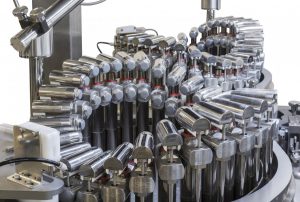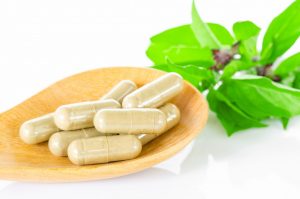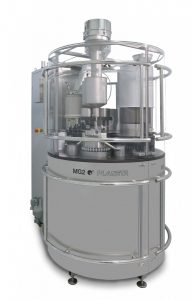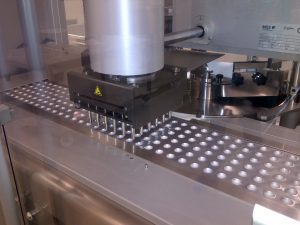Nutraceuticals: MG2’s approach to the market
 The nutraceutical branch is something in between food and pharma and it is constantly growing in North America and Europe. These products require productive processes and volumes similar to pharmaceuticals’, but at the same time they feature different characteristics and problems. MG2’s solutions can satisfy several market requests.
The nutraceutical branch is something in between food and pharma and it is constantly growing in North America and Europe. These products require productive processes and volumes similar to pharmaceuticals’, but at the same time they feature different characteristics and problems. MG2’s solutions can satisfy several market requests.
Nutraceuticals as a bridge between food and drugs
Nutraceutical substances can have positive effects on health, both preventive and therapeutic. They can reduce the risk of cardiovascular and degenerative diseases; they strengthen the immune system; they can help regulate some physical functions (such as intestinal) and they are also used for cosmetic treatments. Among the different kinds of nutraceutical products we can find probiotics (such as lactic ferments), vegetal products such as botanical extracts, herbs and dried fruit, sport supplements (which are often made of branched-chain amino acids or creatine), mineral salts, fish oil derivatives (a source of omega-3).
Each product is characterized by its peculiarities and, by extension, they feature different critical issues in dosing and packaging phases. Supplements are intended for a wide range of consumers: from sportsmen to growing youths, from people who need to integrate their diet to those who employ these products as an adjuvant treatment for medical therapies. Only in Italy, this market is worth approximately 2,5 billion euros, according to IMS Health data, which states at the same time an annual growth of 8% over 2013-2015. In a global view, data published at the end of 2015 by Transparency Market Research show a market value of 165 billion dollars in 2014, expecting to grow and reach up to 280 billion dollars by 2021.
Nutraceuticals and pharmaceuticals are so closely connected that pharmacies are the preferential distribution channel, selling approximately 90% of these kinds of products. Affinities are not limited to this: as for composition and characteristics, nutraceuticals often need to be handled like veritable drugs, although their packaging requirements may have different difficulties.
Features and critical issues: Probiotics
Usually, probiotics dosed into capsules are lyophilized or spray-dried powders. These kinds of powders are particularly affected by humidity and high temperatures; they often show adhesiveness to metal surfaces; in case of anaerobic organisms, the risk of oxidation due to air exposure must be considered. Finally, these products could be damaged if too compressed before being dosed into capsules.
 Features and critical issues: Herbal products
Features and critical issues: Herbal products
Herbal products usually feature low density, poor flowability and irregular granulometry due to the presence of fibres, seeds and other remains caused by the lack of a complete refining process. Moreover, these products are characterized by a poor lubrication which could prevent smooth operation of the mechanical dosing parts. Further complications come from the manufacturers’ need to fill the capsules to their maximum volume, as well as the wide variability of chemical-physical features of the later batches to be produced.
Features and critical issues: Sport supplements, mineral salts and fish oil derivatives
Emblematic is the case of sport supplements which, from a technological point of view, can have an extremely variable profile, depending on their composition and processing. In fact, besides common critical points of all nutraceuticals (such as high adhesiveness and humidity sensitivity), they can also feature an excessive or rather poor flowability. Moreover, sport supplements must fill the capsule to the maximum capacity; the same request comes from manufacturers of mineral salts, such as calcium carbonate. Finally, as for fish oil derivatives, the greatest critical issue is the high stickiness which is typical of products containing omega-3.
Nutraceutical products and MG2: dosators and tamping pin machines
 MG2’s capsule fillers are well introduced in the main small, medium and big Companies working in the field of nutraceuticals, as they can satisfy the most diversified productive requirements. In most cases, the ideal solution for nutraceuticals is based on a volumetric dosator which, combined to the continuous motion, allows the optimal dosage of most powders and granular products.
MG2’s capsule fillers are well introduced in the main small, medium and big Companies working in the field of nutraceuticals, as they can satisfy the most diversified productive requirements. In most cases, the ideal solution for nutraceuticals is based on a volumetric dosator which, combined to the continuous motion, allows the optimal dosage of most powders and granular products.
In MG2’s machines, thanks to the continuous rotary motion, the dosator penetrates the powder layer angularly instead of vertically, at a lower speed compared to intermittent motion machines with tamping pin system. This dosing principle is particularly effective to allow dosing accuracy and constancy, as well as smooth product handling, keeping its features unchanged. These peculiarities are further enhanced by the possibility of MG2’s dosing units to adjust several parameters independently (such as the volume of dosing chamber, the height of powder layer and the compression applied during slug picking), to optimize each time their ideal combination according to the product to be dosed.
Over the last few years, MG2 has also developed a range of intermittent motion machines based on tamping pin dosage, which performs several repeated filling phases, where the product slug is formed by compression. This solution is preferred to a dosator system, in case of ingredients which do not compact easily and therefore require strong compression.
Nutraceutical products and MG2: technological solutions
Over its 50-year experience, MG2 has developed specific solutions for each critical issue related to nutraceuticals. To preserve thermosensitive products, for instance, systems operate with devices suitable to minimize mechanical friction and so reduce heating up of parts in contact with product; to guarantee low humidity, special devices introduce dry air in places where product accumulates (feeding hopper and rotary container) or nitrogen where it is necessary to eliminate oxygen in order to prevent oxidation.
On the other hand, a sticky product could generate clusters and accumulations which may cause variability in dosing weight, density and compactation. In such cases, specific treatments are available, such as finishing of piston and dosator surfaces with anti-adhesive products. Another useful expedient, when it is necessary to fill capsules to their fullest, is to employ enhanced dosing parts combined with a high compression value, and eventually strengthened components and modified blades or Archimedes’ screw to feed bigger quantities of powder.
Biofarma case history: how to dose lactic ferments inside a container insensible to humidity
 A significant case history comes from Biofarma, a Company specialized in contract development and manufacturing of cosmetic products, dietary supplements and medical devices, which turned to MG2 to carry out a system to dose lactic ferments inside blisters placed under container caps: an example of milk-derived probiotics.
A significant case history comes from Biofarma, a Company specialized in contract development and manufacturing of cosmetic products, dietary supplements and medical devices, which turned to MG2 to carry out a system to dose lactic ferments inside blisters placed under container caps: an example of milk-derived probiotics.
In this specific solution distributed by Biofarma, lactobacilli are sealed into a blister inside a container cap; before use, ferments are released into the liquid inside the underlying bottle. The main challenge was to dose lactic ferments, in powder form, into an aluminium container. In fact, lactic ferments are usually dosed into hard shell capsules or single-dose and single-phase plastic caps, for ready-to-use solutions (for example, when powder must be dissolved in water). Anyway, ALU/ALU solution is the only one capable to guarantee a total protection from humidity, which degrades the lactic ferments little by little and makes them ineffective.
MG2 supplied to Biofarma a Flexofill dosing group to be connected to a blister machine, combined with a nitrogen chamber placed between the blister dosage and its covering/sealing, to create and maintain an inert environment in order to protect the product inside the blisters. Flexofill, carried out to dose powders and granular products inside small containers or blisters, can be customized according to the shape, number and position of blisters.
Thanks to a wide range of volumetric dosators which can be easily replaced, Flexofill is suitable not only for nutraceuticals but for many applications, especially to produce blisters used in medical devices for inhalation drugs (DPI).


































